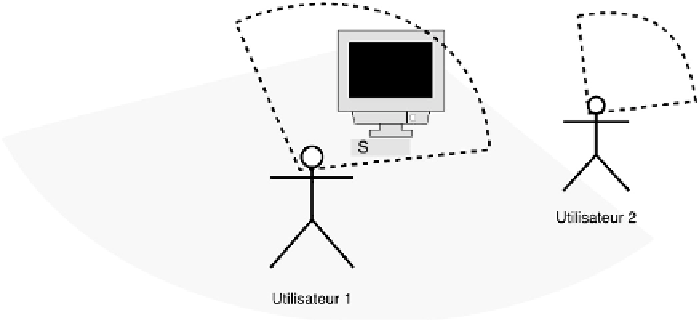Information Technology Reference
In-Depth Information
Figure 10.4.
User 1 can perceive the screen (as it is in his visual field, in dots),
but this is not the case for user 2. Thus, only the former is in the space of
influence of the screen (gray zone)
10.4.3.3.
Sensory proximity: the generative element
In the KUP model, all interactions between entities appear following a particular
event: that is called
sensory proximity
. This event occurs when an entity
e
1
enters
into or leaves the perceptual space of another entity
e
2
2
. Given the previous
definitions of perceptual space and space of influence, it is important to note that
this sensory proximity covers two aspects. First, it refers to spatial proximity
referring to the distance that separates the two entities as well as their respective
orientations. Second, it refers to the capacities in terms of the input/output
modalities of the two entities considered. Thus, a blind user approaching within
50 cm of a screen will not set off a sensory proximity event. It will be the same for a
user situated at the same distance who can see, but who has his back to the screen.
10.4.3.4.
An opportunistic model for the presentation of information
The KUP model enables the information supply phase to be separate from its
presentation phase. When a user (U) penetrates the space of influence of an
information source (K), this source provides one or several relevant pieces of
information. It is possible that at the moment when the user receives the
information, no presentation device (P) is in proximity (as in sensory proximity).
However, as the user is mobile, it is possible that a presentation device penetrates
his perceptual space later on. This will then cause a sensory proximity event that
will have the effect of setting off the process of information presentation on the
device in question.
2 This is equivalent to saying that entity
e
2
enters into the space of influence of
e
1
.








